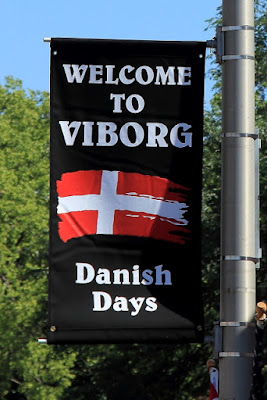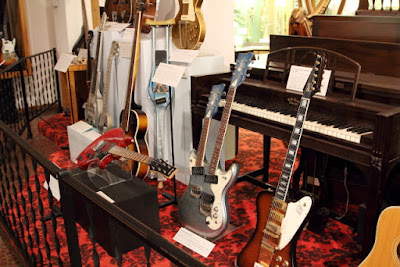Leaving Sioux Falls, we headed west on State Highway 42 toward Pumpkin Center, passing by Wall Lake Corner. (Jeff will probably recognize the southwest corner of State Highway 42 and 463rd Avenue. The Larson house is gone, but Wall Lake Oil is still in existence.)
Arriving at Pumpkin Center (population 0), the only things remaining on the site were some miscellaneous structures, a parked SUV, a few trees, and a South Dakota State Historic Marker.
No one remembers how the community acquired the Name "Pumpkin Center," but a general store was built in 1921 along the dirt trail known as "Custer Battlefield Highway." In 1931 the road was paved, so the residents held a "pavement dance" on the road in front of the store to celebrate the event. However, much to everyone's surprise, Federal G-Men showed up to monitor the event because prohibition was in effect and there were rumors that bootleggers would be selling home-made moonshine. Apparently, no one was arrested.
As auto traffic increased along the highway, a gasoline station was added to the general store. In the 1930s a new car dealership opened, which created a need for an automotive repair garage and a body shop. Then, other stores opened and bus and freight service became available. The town started holding softball and baseball tournaments and the general store sponsored its own team, the "River Rats." Pumpkin Center became a gathering place to meet other people and drink coffee. For decades people used the phrase: "I'll meet you in Pumpkin Center." However, over the years people moved away and the general store, the last of the related enterprises, closed for good in 1993. All of the historic structures have now been removed from the site.
Parker (population 1,024) is the county seat of Turner County and has been credited with hosting the oldest county fair in the State of South Dakota. The first county fair was held in 1880. They also have a nice veterans memorial and a Civil War statue.
Dakota Windmill & Supply is located just outside of Hurley. The company manufactures, rebuilds, and repairs windmills for pumping water from wells all across the United States.
There is a really nice park in Hurley (population 415) that contains picnic tables and a war memorial.
Swan Lake is located south of Hurley and received its name from the body of water that is shaped like a swan. This is a beautiful lake, surrounded by private cabins. From the 1920s to the 1970s there was a resort on the south side of the lake that included a pavilion, band stand, dance floor, roller skating rink, bath house, boat rental fishing supply store, and food service. The pavilion burned down in 1979 and was never replaced.
Viborg (population 782) was founded by Danish settler and the community was named after a city in Denmark. Danish Days, an annual festival, is held each year and attracts people from all over the world. I also learned that the Merchants State Bank would be a good place to do business because a sign in their window said "Ole & Lena Save Here."
The Chamber of Commerce said that the air in Viborg is so great that they have machines to spread Viborg air around the United States. Call Viborg if you need some good South Dakota air!
One of my roommates in college was from Irene (population 437), so while I was in the area I decided to stop and visit the community. Even though this is a small community, parts of Irene are located in three different counties -- Turner, Yankton, and Clay Counties
Spirit Mound was visited by Lewis & Clark on August 25, 1804 because they were told that Indian legends described eighteen inch high evil spirits in human form with large heads that lived there. According to the legend, the little spirits were armed with bow and arrows and could kill someone at a great distance. Lewis & Clark did not discover any evil spirits, but from the top of the mound Clark wrote in his journal that they enjoyed "a most beautiful landscape; numerous herds of buffalo were seen feeding in various directions."
In 1833 the American Fur Company steamer Yellowstone came up the Missouri River and stopped at the Vermillion site so that Francois LeRoi could be put ashore to set up a fur trading post. The site later became Fort Vermillion and in the winter of 1845-46 a party of 200 Mormons from Nauvoo, Illinois, camped at the site. In 1859 emigrants moved into the area and settled along the north bank of the Missouri River; howerver, in 1881 there was a "great flood" that wiped out the entire town, so the town was rebuilt on the bluffs above the river.
The University of South Dakota is located in Vermillion (population 10,571) and the internationally-renowned National Music Museum is located on the campus. The museum has over 15,000 rare musical instruments and about 1,200 instruments are on public display. This is the only place in the world that has two 18th-century grand pianos with the Bartolomeo Cristofori type of action. Additionally, the museum has one of only two Stradivari mandolins known to exist and one of four Stradivari guitars in a museum setting.
The museum was founded in 1973 around the private collection by Arne B. Larson, who was Linda's music teacher when she was younger. His daughter Annette was her good friend.
The towns of Gayville (population 407) and Meckling (population 223) are farming communities west of Vermillion that each support large hay growers in the area. Gayville is the self-proclaimed "Hay Capital of the World;" so not to be outdone, Meckling proclaimed itself to be the "Hay Capital of the Universe." Unfortunately, I missed the best picture of Meckling's advertised "5 Exits." (Five dirt trails leading from the highway.)
Yankton (population 14,454) is the county seat of Yankton County.
When Dakota Territory was created on March 2, 1861, it was 25% larger than Texas. Abraham Lincoln appointed William Jayne Governor on June 8th and at the time, "Dakota had 2,326 white citizens."
The first legislature met at Yankton in 1862 and the legislature named Yankton the permanent capital of the Territory. Then, Alexander Mackenzie came to town with what was reported to be "a satchel full of money," and through some legal maneuvering, the capital was moved to Bismarck, leaving Yankton with a historic marker and the Dakota Territorial Museum. In 2008 the old automotive Missouri River Bridge was decommissioned and it has now been converted into a pedestrian bridge.
Gavins Point Dam is just upstream from Yankton and is the lowermost dam on the Missouri River. Downstream from the dam is the only remaining non-channelized section of the Missouri River and it has now been designated a federal Wild and Scenic River.
Located on the Nebraska side of the river on historic Calumet Bluff is a Lewis & Clark Visitor Center that contains a number of exhibits and offers nice views of Gavins Dam.
A large number of early settlers in this area were Bohemians, so the town of Tabor (population 423) was named after Tabor, Czech Republic, and became known as "The Mother City of Dakota Czechs." The first log school was construed in 1873 and is now maintained by the Czech Heritage preservation Society.
Scotland (population 841) is famous, but the people do not like to talk about it. Sometime in 1873 or 1874 a bag of flaxseed contaminated with Russian Thistle seeds was planted on a farm near Scotland and by 1885 Russian Thistles (tumbleweeds) had reached California and Canada. Tumbleweeds became associated with western United States, particularly ghost towns and other deserted areas, so in 1935 Gene Autry (The Singing Cowboy) wrote a song called "Tumbling Tumbleweeds." Most people our age from South Dakota still know the words to the song!
Olivet (population 74) is the county seat for Hutchinson County and has a nice looking courthouse. With only a population of 74 people, everyone in town must work in the courthouse.
Menno (population 608) has beautiful murals painted on a number of buildings around town. (I would have taken more pictures, but I was running out of storage space on my camera and did not have a backup along.)
Freeman (population 1,306) is known as the "Chislic Capital of the World;" but, unfortunately, I was there on a Sunday and everything was closed. (The community was founded by Mennonites and Hutterites and many people in this area still belong to those faiths.)
For anyone that is old enough to remember Stanley Corner, unfortunately, there is now nothing left to remember!
Canistota Corner, just to the east on Highway 42, has also been deserted.

















































No comments:
Post a Comment